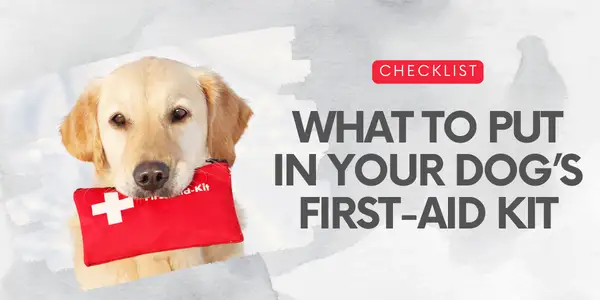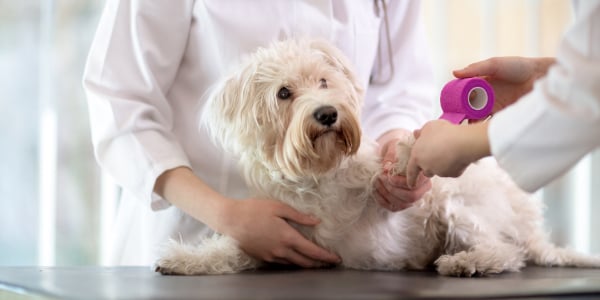 Many pet owners wonder how long it will take their cat or dog's wound to heal, or what they can do to help it heal faster.
Many pet owners wonder how long it will take their cat or dog's wound to heal, or what they can do to help it heal faster.
There isn't a "one-size-fits-all" answer for either of these questions.
But there's definitely something that you should avoid using on your pet's wounds if you don't want to slow down the healing process – hydrogen peroxide.
Why Hydrogen Peroxide Is NOT Ideal for Cleaning Pet Wounds
Growing up, most of us remember our mom or dad running to the medicine cabinet and grabbing the hydrogen peroxide to wash out our cuts and abrasions. Do you remember how it would bubble up? The bubbling process was the blood and other living cells using the catalase enzyme to go after the hydrogen peroxide and break it down into a basic water-wash and oxygen. The bubbling action is what removes the dirt from the wound and works to kill the bacteria. Sounds good, right? Not totally!
Unfortunately, while all of that good-sounding stuff is happening, it is slowing down the body’s natural process to heal itself.
When the peroxide is killing off the bacteria, it is also killing the very cells that your pet’s body is counting on to heal the wound. These cells are called fibroblasts, and they are a crucial component of proper wound healing. This is the main reason why continued wound care with hydrogen peroxide isn’t the best choice.
Your first instinct to clean out your pet’s wound is correct. But the manner in which you do this is also important.
Flushing out wounds is critical for a few reasons. First, flushing removes harmful debris and dirt that can hinder healing and is essential. Second, flushing the wound allows you to evaluate the severity of the wound. Finally, disinfectants cannot work on organic materials (dirt, grass, other particles, etc.). To truly disinfect, just like on a table, you must first have a clean surface.
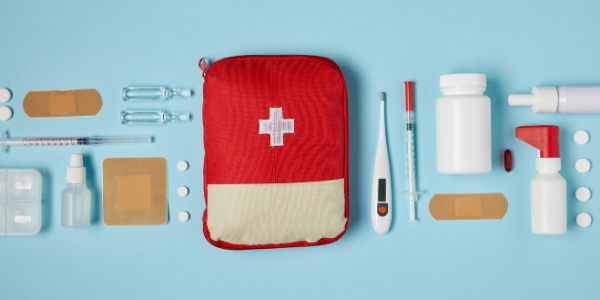
Alternatives to Using Hydrogen Peroxide to Clean a Wound
You are likely wondering what to use if you cannot use hydrogen peroxide. Let me just say, in an emergency where you have absolutely nothing else to use but hydrogen peroxide, a single initial flushing with it is okay, just so you can evaluate the situation. But please do not repeatedly or continually use hydrogen peroxide for your pet's wound.
Questions? To chat with a veterinarian about using hydrogen peroxide or cleaning your pet's wound, Click here
Simple pressurized saline is one of the best options for initial flushing of a wound
Saline matches the pH of the skin, and it doesn’t burn or irritate an open wound. This is ideal because your pet is less likely to resist what you are doing. I highly recommend always keeping some at home (actually, a few bottles because you would be surprised how much it takes to truly flush a wound!) and in your pet's first-aid kit (here is a good wound flush).
Even a simple saline eyewash will work if you don’t have pressurized saline.
Avoid using soaps (unless specifically instructed to do so by your veterinarian – they may give you a special surgical soap), shampoos, rubbing alcohol, herbal preparations, etc., because they can be potentially irritating, hinder healing, and potentially toxic if your pet licks or chews at the wound. Also, soaps and shampoos will require extra rinsing and handling of an already painful site.
One time, you may need a mild soap, such as Dawn, is if your pet has grease or oil in the areas surrounding the wound. I have seen pets have wounds from getting under cars or in the engines, and they are covered in grease and/or oil. In this case, cover the wound in sterile water-soluble lube (single-use lube packets are perfect for pet first-aid kits) and lightly cover it with gauze and a vet wrap. This will protect the wound and prevent the soap from irritating the area. After the cleaning and rinsing are complete, remove the wrap and use the saline to rinse the site free of lube.
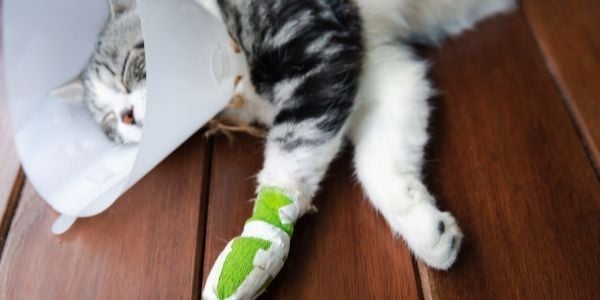
When Is it OK to Use Hydrogen Peroxide in Cleaning Pet Wounds?
There are times when your veterinarian might deem hydrogen peroxide as necessary in the management of your pet’s wound (see, you didn’t need to throw that bottle away!). I recommend that you carefully follow the instructions given to you by your veterinarian for its use. They will have specific reasons for using it in the manner they suggest to expedite the healing of the wounds.
Some reasons for using hydrogen peroxide include:
- Flushing or Cleaning Drains: Your veterinarian may have placed a drain at the surgical site of your pet’s wound. You can dilute hydrogen peroxide with water (about 50/50) and clean the openings where the drain is poking out through the skin. This helps prevent fluid from building up under the skin. Also, if it is a solid type drain (a tube), you can use this method to flush the inside of the drain using a syringe.
- Cleaning: Cleaning the fur where the drain has been draining/leaking. Wet the fur with the hydrogen peroxide, let it sit for a minute or two, and then gently wipe or comb the bloody discharge from the fur. Leaving the fluid drainage from a wound on the fur can cause skin irritation if left in place.
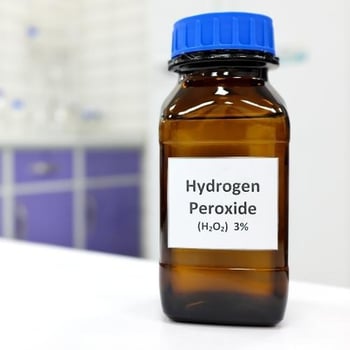 Other uses for hydrogen peroxide:
Other uses for hydrogen peroxide:
Here are some other non-wound-related uses for hydrogen peroxide:
- Blood removal from fabric: If blood from the wound gets on fabric or your pet’s collar, soaking the fabric (test a hidden spot first) or your pet’s collar will remove most of the blood. It always worked great for my scrubs when I was at work because let’s face it, clients didn’t want to see me come into an exam room with a bloody top!
- Poisoning or Toxicity (dogs): Hydrogen Peroxide can be good to have on hand should you ever need to make your dog* throw up at home (sometimes necessary when they eat a food or poison that they shouldn't have — just don't use anything over 3% Hydrogen Peroxide for this and be careful with "Food-Grade" Hydrogen Peroxide).
*DOG CAUTION: In some instances, and with some substances, inducing vomiting can actually be more dangerous for your dog than the thing they've swallowed (e.g., burning again on the way back up through the esophagus, or getting into their lungs and causing pneumonia).
With any poisoning emergency, call your veterinarian, an Animal ER, or a dedicated pet poison control hotline before trying to make your pet vomit. They can let you know if making them vomit is safe and appropriate, and can help talk you through the procedure if needed.
*CAT CAUTION: Please don't use hydrogen peroxide to try to make your cat vomit at home. Cats have an increased risk of developing debilitating necroulcerative hemorrhagic gastritis (read: dead and bleeding stomach lining cells) when hydrogen peroxide is used to cause vomiting in them.
- De-skunking: If you ever need to de-skunk your pet, hydrogen peroxide is a great ingredient. Check out our recipes for de-skunking.
How to Monitor Your Pet's Healing
I want to close by giving you some ideas on what to look for regarding your pet’s wound, to know if it is infected when it is healing, and about how long the healing process will take.
Wounds are tricky, and proper care and management are critical in order to prevent infection and help them heal faster. With all wounds (unless really minor, like an abrasion), I recommend contacting your veterinarian. In a lot of cases, especially if the cause is unknown, antibiotics and even pain medications may be needed. In addition to this, many wounds need surgical treatment, which will help shorten the length of time until the site is healed.
How to Tell if Your Pet's Wound Is Infected
Even if your pet’s wound is properly cleaned and treated, there is always a risk of infection. Why, you may ask? There are a few reasons this can occur. In some cases, decontamination (getting the ‘junk’ out) may not be completely possible even with the best of techniques. The bacteria present may be resistant to the particular antibiotic chosen. Lastly, pets don’t always follow the rules, and they lick, chew, or somehow find a way to get their wound dirty.
If your pet’s wound becomes infected, there are a few things you may notice. The area may develop an odor – it may be a mild odor or a foul and disgusting odor. The area will become ‘hot’ to the touch and seem more painful. Finally, you may notice a yellowish, greenish, or even grayish discharge or material building up. If you notice any of these signs or if anything seems to change abnormally, be sure to contact your veterinarian ASAP.
Questions? To chat with a veterinarian about using hydrogen peroxide or cleaning your pet's wound, Click here
How to Tell if Your Pet's Wound Is Healing
You may be wondering how you will know if the wound is healing. If the wound was surgically closed, the incision will look clean (redness and discoloration will gradually decrease, and swelling will subside), and the discharge (if a drain was placed) will lessen each day.
If the wound had to heal without surgery, due to being contaminated or not enough skin to close it, you will notice a healthy pink color to the tissue, formation of granulation tissue (formation of tissue that looks like rounded masses of tissue), wound contracture (keeps getting smaller and smaller), and smooth pinkish ‘skin’ around the margins. It is completely normal to have some bleeding when the bandages are being changed and the wound is being flushed. As long as it is mild and not profuse, it indicates healing.
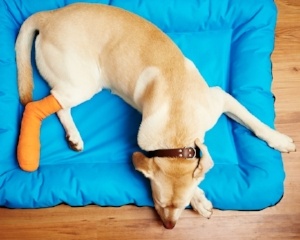
How Long Does it Take a Wound to Heal?
Lastly, I know you want to know how long this whole process will take. If the wound is fresh, cleaned properly, and surgery is performed, the process will usually be complete in about two weeks. That is assuming that no secondary infections occur or that the incision doesn’t get reopened.
If it is an older wound, the veterinarian may manage it for a week or two as an “open wound” (basically flushing and repeatedly bandaging) until there is a healthy bed of tissue and then surgically close. This process can take about four to six weeks. The last two situations will likely take the longest. If the wound can only be partially closed or not surgically closed at all, this process, depending on the severity of the wound, may take up to two months or more.
Sadly, it is hard to put a timeline on this situation because there are so many factors that can affect or slow the healing process. Some such factors are the degree of the initial infection, the size and depth of the wound, pet age, and health status, pet compliance (how agreeable your pet is to bandages and wearing a cone), etc. If you find yourself in this last situation, be patient and be sure to follow the instructions of your veterinarian closely.





